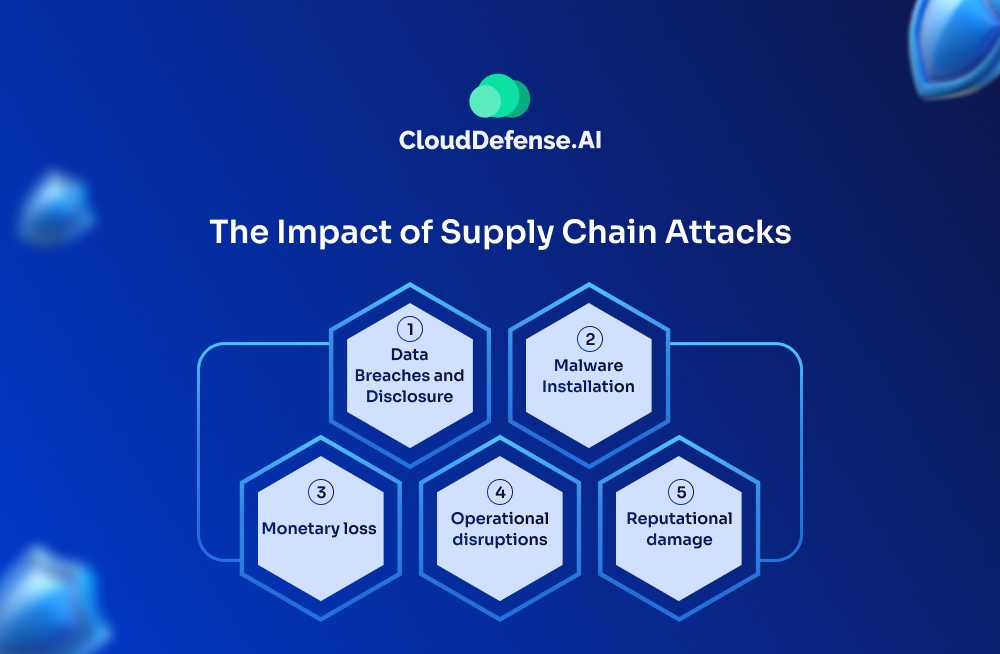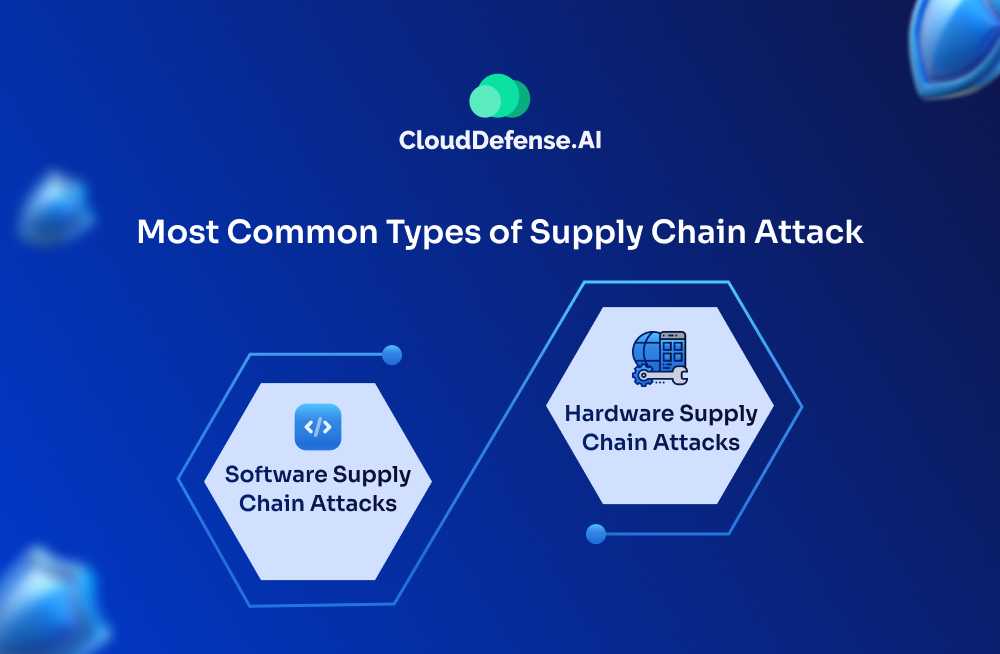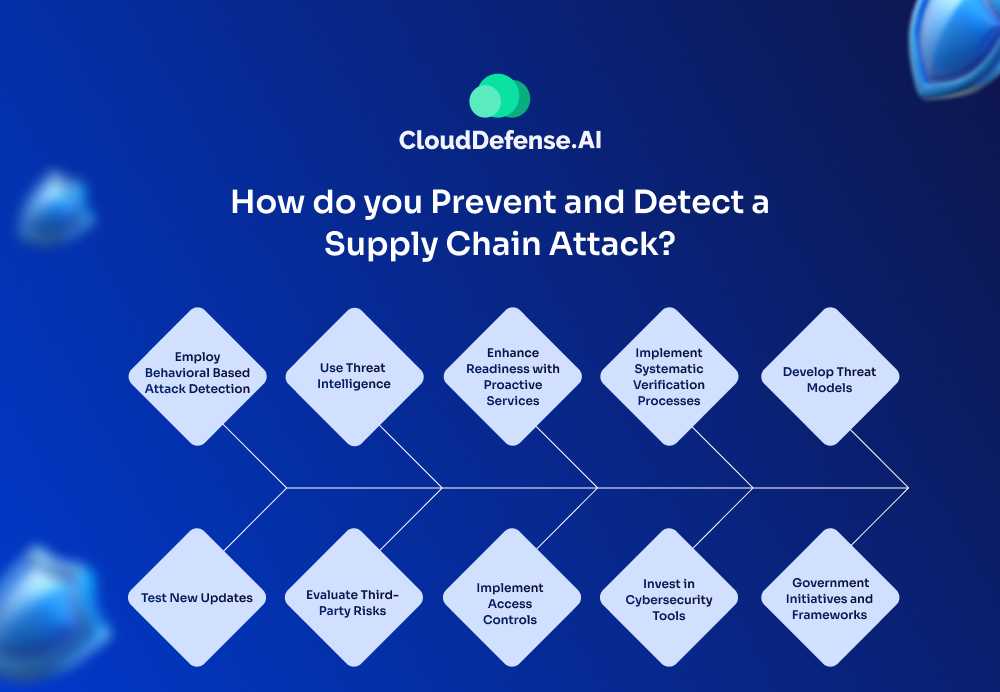Definition — What Is a Supply Chain Attack?
What if one trusted their closest ally, only to discover that their trust was the weak link exploited by attackers? A supply chain attack does just that—compromising your security by infiltrating third-party vendors, software, or hardware providers you rely on. By targeting these dependencies, adversaries bypass traditional defenses, embedding themselves in your systems through seemingly legitimate updates or services.
Can you be 100% certain every component in your digital ecosystem is secure? That’s the unsettling question a supply chain attack forces you to confront.
So, what it does:
- Targets trusted software, hardware, or service providers to spread malicious code or gain unauthorized access.
- Exploits weak links in supply chain security, often overlooked in traditional risk assessments.
- Bypasses perimeter defenses by using the trust placed in third-party systems or updates.
- Leverages compromised supply chains to escalate access, deploy ransomware, steal sensitive data, or disrupt operations.
These attacks are rising because of increasing third-party dependencies and interconnected ecosystems. If your organization isn’t securing its supply chain, it’s not securing its future.
What Does Statistics Say about Supply Chain Attacks?
The growing threat of supply chain attacks is not just theoretical—it’s a reality affecting businesses across industries, from finance and government to e-commerce. The interconnected nature of modern supply chains amplifies the impact, where a single compromised vendor can cascade into widespread chaos.
Key Statistics That Demand Attention:
- In 2023, supply chain cyberattacks in the United States affected 2,769 entities—the highest number reported since 2017. This represents a staggering 58% year-over-year increase, highlighting the accelerating risk.
- The average cost of a supply chain attack exceeded $4.46 million in 2023, according to IBM’s Cost of a Data Breach report.
- Industries like healthcare, finance, and retail are the most frequently targeted due to their reliance on third-party vendors.
These numbers convey a clear message: supply chain security is not optional. It’s a necessity for survival in today’s threat landscape. Are these risks part of your security equation? If not, it’s time to rethink your strategy.
The Impact of Supply Chain Attacks

Let’s talk about the real damage that a supply chain attack can cause—because it’s huge. This is not some small issue. It can cripple your business, hit your bottom line, and take years to recover from. Here’s what happens:
1. Data Breaches and Disclosure
When attackers get into the supply chain, they can access critical data. This includes sensitive information, client data, or, worse, login credentials. They can spy on data traffic, steal confidential information, and even take control of accounts. Once that data is gone, it’s out of your hands. The consequences for your company, and your customers, can be devastating.
2. Malware Installation
The next big risk is malware. Attackers use the supply chain as a way to install harmful software on your network. This could be anything from ransomware that locks up your systems to keyloggers that steal passwords, or viruses that spread across your infrastructure. It can cripple your operations, and it’s not something you want to be dealing with.
3. Monetary loss
Supply chain attacks can cost you big. Employees can be tricked into wiring money to the wrong account or paying fake invoices. If that happens, you could lose millions, and it could take a long time to figure out how to stop it from happening again.
4. Operational disruptions
If an attack takes down your supply chain, everything grinds to a halt. That means delays, loss of production, downtime, and frustrated customers. Operational disruptions are a serious problem. They cost time, they cost money, and they cost you credibility.
5. Reputational damage
Your reputation is everything. Once a supply chain attack happens, it’s out there. People start to question your reliability. You lose trust from clients and vendors, and it’s not something you can just fix with a press release. It takes time—years— to rebuild that trust, and some may never come back.
In the end, supply chain attacks aren’t just a technical problem. They are a business problem. A big one. You can’t afford to let these vulnerabilities go unnoticed. Get ahead of the issue before it costs you everything.
How does a Supply Chain Attack Work?
A supply chain attack is one of the most effective and dangerous tactics used by cybercriminals today. It’s not just about hacking into a single system; it’s about leveraging trust and scale to infiltrate multiple organizations at once. Let me break this down step by step:
Step 1: The Starting Point: Legitimate Source Code
Every organization begins with legitimate source code. This is the backbone of any software development process. Developers build this code, often using trusted tools and libraries, assuming their environment is secure. But that’s where the problem begins—trust. Trust in the tools, trust in the process, and trust that nothing will go wrong.
Step 2: Attackers Target the Build Process
The build process is where everything gets compiled and packaged into a working product. This is the most critical stage, and it’s here that attackers make their move. They infiltrate the environment—maybe through a vulnerability in a third-party library or by exploiting weak access controls. Once inside, they introduce malware into the software. The code looks clean to the developers, but it’s not. It’s compromised.
Step 3: The Update Server Becomes the Attack Vector
Once the software is built, it’s uploaded to the organization’s update server. These servers are the lifeblood of software distribution. Customers rely on them to get updates and patches that fix bugs and improve performance. But now, instead of safe updates, the server is delivering malicious software directly to users.
Step 4: Malware Reaches the End Users
The compromised software is pushed out as part of regular updates. Customers install it without question because they trust the organization providing it. At this stage, the malware is deployed to potentially thousands, even millions, of systems. The scale of the attack grows exponentially.
Step 5: Exploitation Begins on Customer Systems
Once the malware is installed, the attackers gain a foothold on the customer’s systems. From here, they can do almost anything—steal sensitive data, monitor communications, or launch additional attacks. It’s no longer just about the initial organization. Now the attacker has access to everyone in the chain.
Step 6: Command and Control Server Takes Over
The malware isn’t acting alone. It’s programmed to communicate back to the attacker’s command and control (C&C) server. This is where the real damage happens. The attackers send commands, extract data, and manipulate systems—all remotely. This allows them to remain in control without being physically present.
This type of attack is powerful because it exploits the interconnectedness of today’s systems. Companies trust their supply chains, customers trust the companies, and attackers exploit that trust at every level. It’s not just a cybersecurity issue; it’s a trust issue, and the consequences are massive. If you’re not thinking about how to secure your supply chain, you’re already a step behind.
Example of Supply Chain Attack
As we discussed before, a supply chain attack works by exploiting the trust between an organization and its third-party service providers. In this example, an attacker targets a third-party ad company, which is commonly used by multiple e-commerce websites.
Instead of attacking the websites directly, the attacker compromises the ad company and injects malicious code into its services. Since the ad company’s code is integrated into numerous e-commerce websites, the malicious code automatically spreads to all of them.
When users visit these websites, they unknowingly interact with the compromised system, exposing them to risks like stolen data, malware, or being redirected to harmful sites. This type of attack shows how vulnerabilities in one link of the supply chain can impact an entire ecosystem.
Most Common Types of Supply Chain Attack

Let’s focus on two of the most common types of supply chain attacks: Software and Hardware supply chain attacks. Both can cause significant damage, but they differ in how they infiltrate and affect an organization. Here’s a quick breakdown:
1. Software Supply Chain Attacks
These attacks target software updates or services used by the organization. Attackers compromise software, inject malicious code, or exploit vulnerabilities in software components or dependencies. The malicious code is then distributed through official software channels, giving attackers access to systems once the software is deployed.
2. Hardware Supply Chain Attacks
Hardware supply chain attacks are more physical in nature. Attackers compromise hardware components, like servers, routers, or networking devices, during the manufacturing process or while in transit. Once the compromised hardware is installed, it can be used to gain unauthorized access to an organization’s network or to spy on internal systems.
Here’s a quick summary:
| Aspect | Software Supply Chain Attacks | Hardware Supply Chain Attacks |
| Entry Point | Compromised software updates, patches, or dependencies. | Manipulated or compromised hardware components during manufacturing or transit. |
| Method of Attack | Inserting malicious code or vulnerabilities into software. | Implanting malicious hardware or altering hardware components. |
| Scope | Affects all organizations using the compromised software. | Affects organizations that install or use the compromised hardware. |
| Impact | Data breaches, malware installation, system compromise through software. | Unauthorized access, espionage, network disruptions via hardware manipulation. |
| Detection Difficulty | Hard to detect since the attack hides in routine software updates. | Can be harder to detect due to the physical nature of the attack. |
How do you Prevent and Detect a Supply Chain Attack?

Preventing and detecting supply chain attacks requires a multi-faceted approach, incorporating both proactive measures and reactive strategies. Here are some recommendations on how organizations can enhance their supply chain security:
1. Employ Behavioral-Based Attack Detection
Traditional detection systems often fail because they rely on known signatures. A smarter approach involves understanding behavioral patterns in your ecosystem. Attackers often test access or create slight disruptions before a full-scale attack—these subtle anomalies are where behavioral analysis shines. Invest in tools that focus on these micro-signals to catch threats before they escalate.
Many supply chain attacks involve “living-off-the-land” techniques, where attackers use built-in tools like PowerShell or WMI, making detection even harder. Behavioral detection systems that recognize unusual usage patterns of legitimate tools can significantly strengthen your defenses
2. Use Threat Intelligence
Most companies treat threat intelligence as a static feed of information, but it’s much more than that. The true value lies in using threat intelligence dynamically—merging it with internal data and applying it to your unique environment. Real threat intelligence helps you predict how an attacker might target you specifically, not just broadly.
For instance, mapping your third-party vendors to known attack patterns can help prioritize which relationships pose the highest data breach risk. Few organizations are doing this, yet it can reveal critical blind spots.
3. Conduct Vendor Profiling, Not Just Assessments
Many organizations rely on compliance checklists to vet vendors, but these often miss deeper issues. Instead, consider creating detailed risk profiles for your vendors. What’s their history with breaches? Do they have a reputation for transparency? Are they quick to patch vulnerabilities?
One overlooked aspect: cultural and organizational practices. A vendor with a strong security culture is far less likely to be exploited. Regularly engage in open conversations about their practices—don’t just rely on formal assessments.
4. Regularly Simulate Realistic Attack Scenarios
Supply chain attacks are unpredictable, but your readiness doesn’t have to be. While tabletop exercises are common, few companies simulate attacks that account for real-world constraints like staff turnover or time pressure during an incident.
Here’s a tip: During your next exercise, remove key team members to see how the rest respond under stress. This helps identify whether your processes rely too heavily on specific people rather than systems and structures.
5. Strengthen Access Control Through Continuous Auditing
Access controls are often treated as “set and forget,” but this mindset is dangerous. Attackers exploit overlooked areas like orphaned accounts (accounts belonging to former employees or contractors) or improperly configured access policies.
Regularly audit not just who has access but why they need it. You’ll often uncover unnecessary privileges granted due to convenience, creating vulnerabilities that attackers love to exploit.
6. Align Patch Management With Operational Requirements
Everyone talks about patching, but few discuss the hidden challenges. In a supply chain, patching isn’t just about speed—it’s about timing. Patching too quickly can disrupt systems, especially in environments where vendor-provided software plays a critical role.
The solution? Work closely with vendors to align on patch schedules. Push for transparency on how their updates are tested. Some companies even negotiate patching SLAs with their partners—a rarely discussed but highly effective strategy.
7. Establish Transparent and Trustworthy Vendor Relationships
Trust is often assumed in vendor relationships, but it should be earned and maintained. Implement mutual transparency agreements where vendors regularly share their security practices, audit results, and cloud risk management strategies.
Explore blockchain-based tools for supply chain visibility. These technologies can create tamper-proof records of transactions and interactions, providing an extra layer of security and accountability.
8. Integrate Monitoring With Operational and Business Context
Many organizations monitor their supply chain in silos—IT watches for breaches, while operations track efficiency. This separation creates blind spots. Integrate monitoring tools that provide both technical and business context, so you can see how an attack could disrupt your operations, not just your network.
For example, a supplier’s delayed response to a vulnerability may not seem critical, but when paired with operational data (e.g., their products are critical to a high-revenue project), it becomes a top priority.
How can CloudDefense.AI Help?
CloudDefense.AI offers a comprehensive suite of application security tools to help you safeguard your supply chain against evolving threats. Our platform includes:
- SCA (Software Composition Analysis): SCA helps identify vulnerabilities in open-source dependencies while ensuring compliance with licensing requirements, safeguarding your applications from supply chain risks.
- SAST (Static Application Security Testing): SAST detects vulnerabilities in your source code during the development phase, allowing you to address security issues early and build secure software from the start.
- DAST (Dynamic Application Security Testing): DAST uncovers security gaps in running applications, enabling you to identify and fix potential exploits before they can be leveraged by attackers.
- IaC (Infrastructure as Code) Scanning: IaC scanning identifies misconfigurations in your infrastructure templates, preventing vulnerabilities from being introduced into your cloud environment.
- Auto Remediation: Auto remediation streamlines vulnerability management by providing automated fixes, reducing manual effort and accelerating risk mitigation.
These tools work together to provide end-to-end visibility and proactive protection, ensuring your supply chain remains secure and resilient. With CloudDefense.AI, you gain the confidence to address risks comprehensively, safeguard sensitive data, and maintain trust across your ecosystem.
Take the first step toward securing your supply chain today. Schedule a demo with CloudDefense.AI and see how we can transform your application security strategy.







